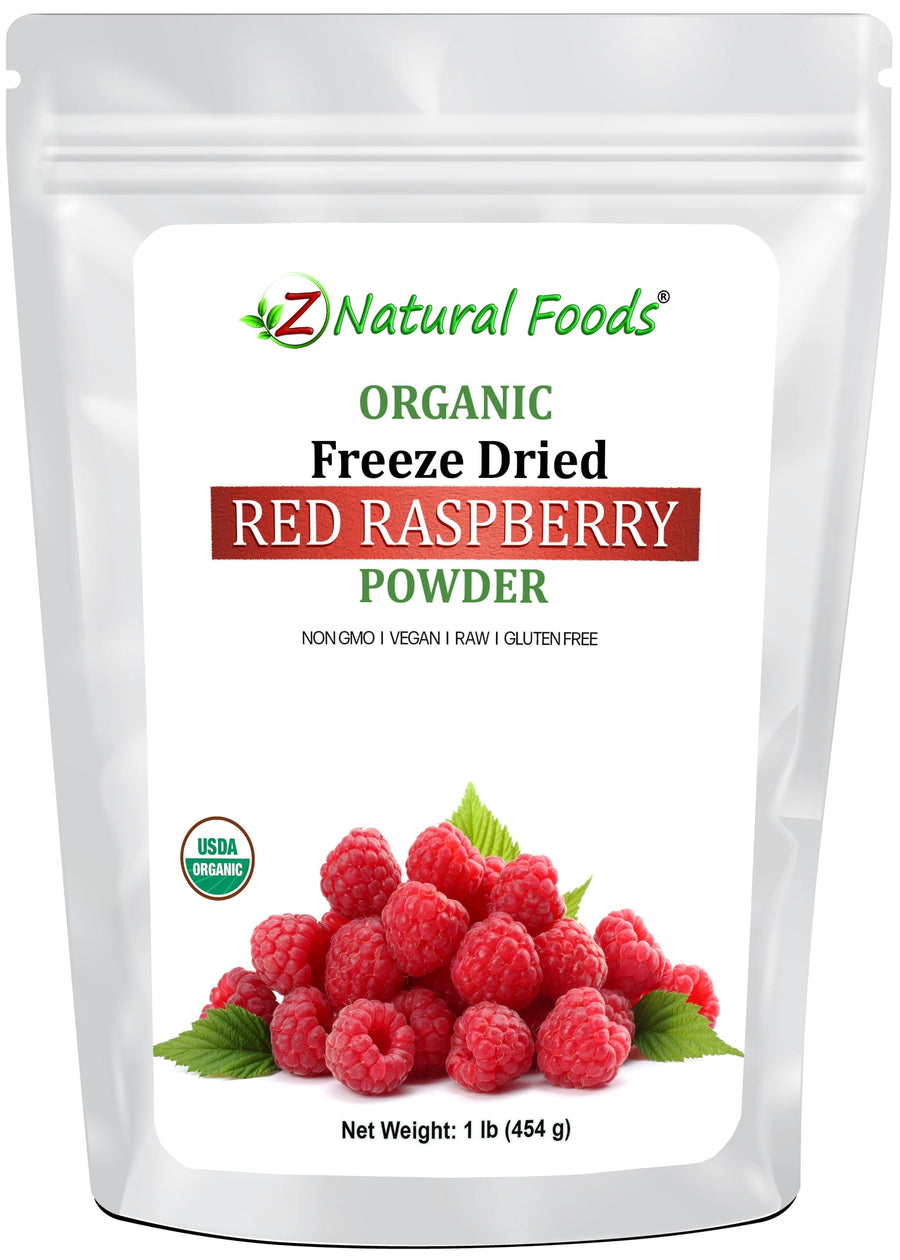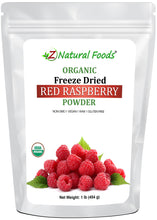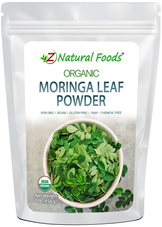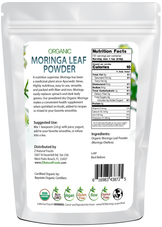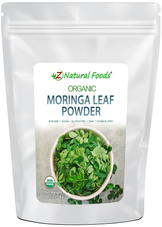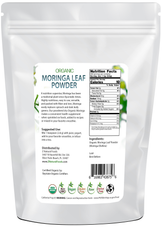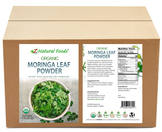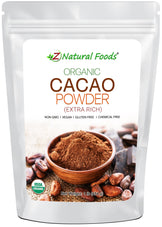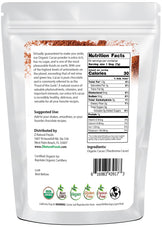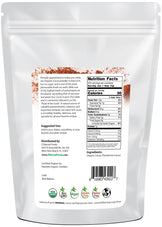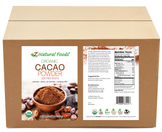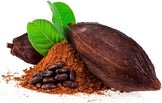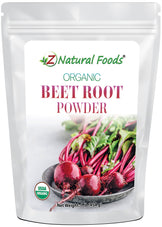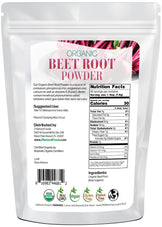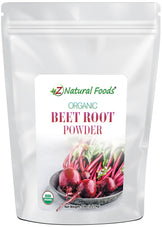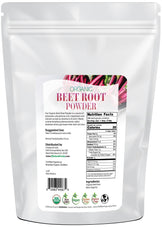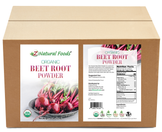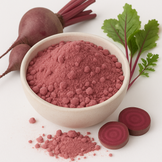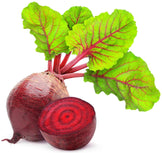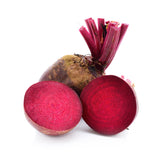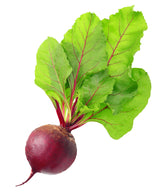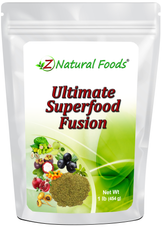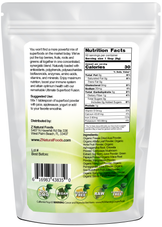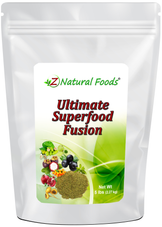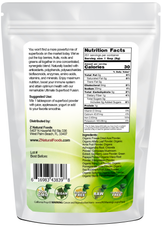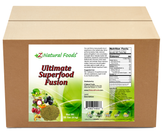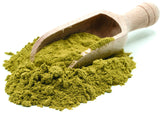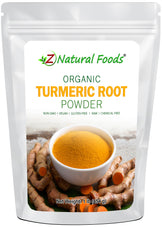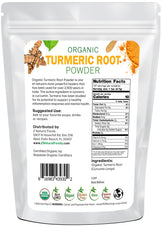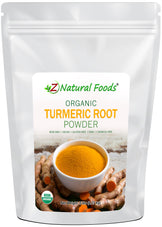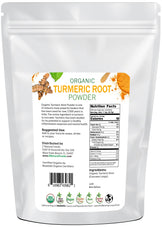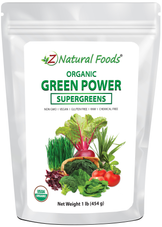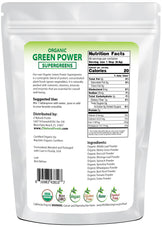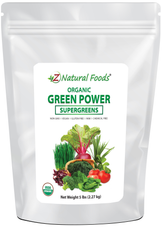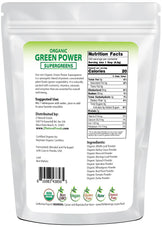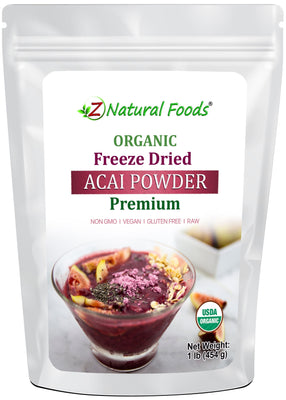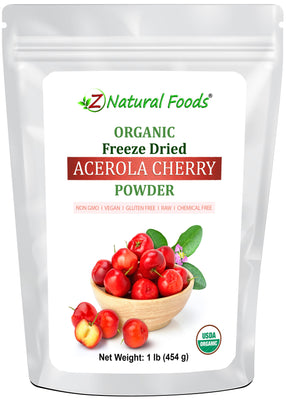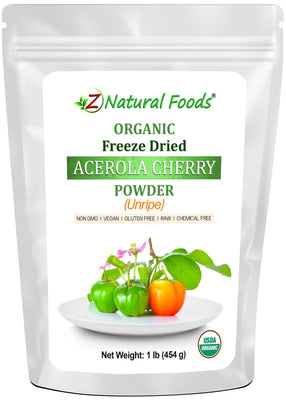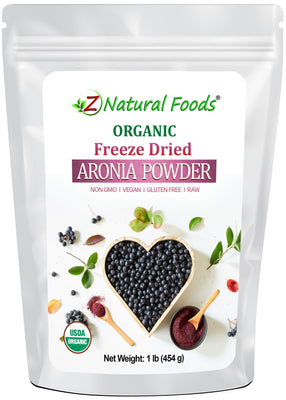About Product
Organic Freeze-Dried Red Raspberry Powder is made from ripe, freshly harvested raspberries that are carefully freeze-dried and milled into a fine powder. This process preserves the fruit’s vibrant color, tart-sweet flavor, and natural aroma, making it a convenient alternative to fresh raspberries. It blends easily into smoothies, shakes, teas, and juices for a fruity boost.
Shelf-stable and versatile, freeze-dried raspberry powder is also perfect for baking, desserts, sauces, and even savory dishes. Sprinkle it over yogurt or oatmeal, mix it into frostings, or stir it into pancake and muffin batters. With its bright flavor and easy-to-use form, it’s a simple way to enjoy raspberries year-round.
Constituents of Red Raspberry include:
- Minerals: Calcium, Iron, Magnesium, Phosphorus, Potassium, Zinc, Copper, Manganese, Selenium
- Vitamins: Vitamin C, Thiamin, Riboflavin, Niacin, Pantothenic Acid, Vitamin B-6, Folate, Choline, Betaine, Vitamin A (RAE), Vitamin A (IU), Lutein & Zeaxanthin, Vitamin E, Beta Tocopherol, Gamma Tocopherol, Delta Tocopherol, Vitamin K
- Amino Acids: Tryptophan, Threonine, Isoleucine, Leucine Lysine, Methionine, Cystine, Phenylalanine, Tyrosine, Valine, Arginine, Histidine, Alanine, Aspartic Acid, Glutamic Acid, Proline, Serine
- Anthocyanidins: Petunidin, Delphinidin, Malvidin, Peonidin, Cyanidin
- Flavan-3-: Catechin, Epigallocatechin, Epicatechin
- Flavonols: Kaempferol, Quercetin
- Proanthocyanidins: Proanthocyanidin Monomers, Proanthocyanidin Dimers, Proanthocyanidin Trimers, Proanthocyanidin 4-6mers, Proanthocyanidin 7-10mers
Suggested Use: Mix one tablespoon with recipes, juice, yogurt, or chocolate.
Mixing Suggestions: To increase flavor and nutritional profile, combined with our organic extra-rich cacao powder.
Botanical Name: Rubus idaeus.
Other Names: Red Raspberry, Raspbis, Hindberry, Bramble of Mount Ida, Bramblebush, Raspberry.
Parts Used: Whole Raspberry (Including Seeds).
Ingredients: Raw Freeze-Dried Raspberry.
Origin: Grown and Freeze-Dried in the USA. Packaged with care in Florida, USA.
Certifications: Certified USDA Organic.
How to Maintain Optimum Freshness
- This product is packaged in airtight stand-up, resealable foil pouches for optimum freshness.
- Once opened, push the air out of the pouch before resealing it to preserve maximum potency.
- Keep your powder in a cool, dark, dry place.
This product is 100% natural and minimally processed:
Taste, smell, texture, and color vary from batch to batch. Go here to learn why our products may naturally vary.
The important protections we take to bring you safe and nutritious superfoods:
Please go here to discover the essential steps we take to deliver fresh, quality nutrition.
Bulk Quantities?
Need to order a large quantity of our products? We are happy to help! Please get in touch with our Bulk department to discuss the details.
* Product packaging, pictures, and origin may vary.
Sources & References
1. Huxley, A., ed. (1992). New RHS Dictionary of Gardening. Macmillan ISBN 0-333-47494-5.
2. Strick, B.C. "Growing Raspberries in Your Home Garden". Growing Small Fruits. Oregon State University Extension Service. Retrieved 18 August 2011.
3. "Health and healing fact sheets, Red Raspberries".
4. Iannetta, P. P. M.; Wyman, M.; Neelam, A.; Jones, C.; Taylor, M. A.; Davies, H. V.; Sexton, R. (December 2000). "A causal role for ethylene and endo-beta-1,4-glucanase in the abscission of red-raspberry (Rubus idaeus) drupelets". Physiol Plant 110 (4): 535"“543. doi:10.1111/j.1399-3054.2000.1100417.x.
5. World's Healthiest Foods, in-depth nutrient profile for raspberries. Whfoods.org. Retrieved on 2012-09-24.
6. Journal of Agricultural and Food Chemistry Presents Research from the 2007 International Berry Health Benefits Symposium, Journal of Agricultural and Food Chemistry ACS Publications, February 2008
7. Carvalho, Elisabete; Fraser, P.D.; Martens, S. (2013). "Carotenoids and tocopherols in yellow and red raspberries". Food Chemistry 139: 744"“752. doi:10.1016/j.foodchem.2012.12.047.
8. Liu M, Li XQ, Weber C, Lee CY, Brown J, Liu RH (May 2002). "Antioxidant and antiproliferative activities of raspberries". J. Agric. Food Chem. 50 (10): 2926"“30. doi:10.1021/jf0111209. PMID 11982421.
9. Heinonen M (June 2007). "Antioxidant activity and antimicrobial effect of berry phenolics"”a Finnish perspective". Mol Nutr Food Res 51 (6): 684"“91. doi:10.1002/mnfr.200700006. PMID 17492800.
10. Cerdá B, Tomás-Barberán FA, EspÃn JC (January 2005). "Metabolism of antioxidant and chemopreventive ellagitannins from strawberries, raspberries, walnuts, and oak-aged wine in humans: identification of biomarkers and individual variability". J. Agric. Food Chem. 53 (2): 227"“35. doi:10.1021/jf049144d. PMID 15656654.
11. "Statistics from: Food And Agricultural Organization of United Nations: Economic And Social Department: The Statistical Division". UN Food and Agriculture Organization Corporate Statistical Database.
12. RHS Plant Selector Rubus idaeus 'Glen Moy' PBR (F) AGM / RHS Gardening. Apps.rhs.org.uk. Retrieved on 2012-09-24.
13. RHS Plant Selector Rubus idaeus 'Malling Jewel' (F) AGM / RHS Gardening. Apps.rhs.org.uk. Retrieved on 2012-09-24.
14. RHS Plant Selector Rubus idaeus 'Glen Ample' PBR (F) AGM / RHS Gardening. Apps.rhs.org.uk. Retrieved on 2012-09-24.
15. RHS Plant Selector Rubus idaeus 'Glen Prosen' PBR (F) AGM / RHS Gardening. Apps.rhs.org.uk. Retrieved on 2012-09-24.
16. RHS Plant Selector Rubus idaeus 'Leo' PBR (F) AGM / RHS Gardening. Apps.rhs.org.uk. Retrieved on 2012-09-24.
17. RHS Plant Selector Rubus idaeus 'Malling Admiral' (F) AGM / RHS Gardening. Apps.rhs.org.uk. Retrieved on 2012-09-24.
18. RHS Plant Selector Rubus idaeus 'Autumn Bliss' (F) AGM / RHS Gardening. Apps.rhs.org.uk. Retrieved on 2012-09-24.
19. Spooner farms certified raspberry Plants "Planting Information"
20. Aiyer HS, Li Y, Liu QH et al. Dietary freeze-dried black raspberry's effect on cellular antioxidant status during reflux-induced esophagitis in rats. Nutrition, Volume 27, Issue 2, February 2011, Pages 182-187.
21. Ali L, Svensson B, Alsanius BW et al. Late season harvest and storage of Rubus berries-Major antioxidant and sugar levels. Scientia Horticulturae, Volume 129, Issue 3, 27 June 2011, Pages 376-381.
22. Beekwilder J, Hall RD and de Vos CH. Identification and dietary relevance of antioxidants from raspberry. Biofactors. 2005;23(4):197-205. 2005.
23. Bobinaite R, Viskelis P and Venskutonis PR. Variation of total phenolics, anthocyanins, ellagic acid and radical scavenging capacity in various raspberry (Rubus spp.) cultivars. Food Chemistry, Volume 132, Issue 3, 1 June 2012, Pages 1495-1501.
24. Borquez RM, Canales ER and Redon JP. Osmotic dehydration of raspberries with vacuum pretreatment followed by microwave-vacuum drying. Journal of Food Engineering, Volume 99, Issue 2, July 2010, Pages 121-127.
25. Bowen-Forbes CS, Zhang Y and Nair MG. Anthocyanin content, antioxidant, anti-inflammatory and anticancer properties of blackberry and raspberry fruits. Journal of Food Composition and Analysis, Volume 23, Issue 6, September 2010, Pages 554-560.
26. Cekic C and Ozgen M. Comparison of antioxidant capacity and phytochemical properties of wild and cultivated red raspberries (Rubus idaeus L.). Journal of Food Composition and Analysis, Volume 23, Issue 6, September 2010, Pages 540-544.
27. Goto T, Teraminami A, Lee JY et al. Tiliroside, a glycosidic flavonoid, ameliorates obesity-induced metabolic disorders via activation of adiponectin signaling followed by enhancement of fatty acid oxidation in liver and skeletal muscle in obese"“diabetic mice. The Journal of Nutritional Biochemistry, Volume 23, Issue 7, July 2012, Pages 768-776.
28. Haffner K, Rosenfeld HJ, Skrede G et al. Quality of red raspberry Rubus idaeus L. cultivars after storage in controlled and normal atmospheres. Postharvest Biology and Technology, Volume 24, Issue 3, April 2002, Pages 279-289.
29. Jeong JB and Jeong HJ. Rheosmin, a naturally occurring phenolic compound inhibits LPS-induced iNOS and COX-2 expression in RAW264.7 cells by blocking NF-kappa B activation pathway. Food and Chemical Toxicology, Volume 48, Issues 8"“9, August"“September 2010, Pages 2148-2153.
30. Jeong JH, Jung J, Lee SR et al. Anti-oxidant, anti-proliferative and anti-inflammatory activities of the extracts from black raspberry fruits and wine. Food Chemistry, Volume 123, Issue 2, 15 November 2010, Pages 338-344.
31. Jin P, Wang SY, Gao H et al. Effect of cultural system and essential oil treatment on antioxidant capacity in raspberries. Food Chemistry, Volume 132, Issue 1, 1 May 2012, Pages 399-405.
32. McDougall GJ, Kulkarnni NN and Stewart D. Berry polyphenols inhibit pancreatic lipase activity in vitro. Food Chemistry, Volume 115, Issue 1, 1 July 2009, Pages 193-199.
33. Miromoto C, Satoh Y, Hara M et al. Anti-obese action of raspberry ketone. Life Sciences, Volume 77, Issue 2, 27 May 2005, Pages 194-204.
34. Ochoa MR, Kesseler AG, Vullioud MB et al. Physical and Chemical Characteristics of Raspberry Pulp: Storage Effect on Composition and Color. LWT - Food Science and Technology, Volume 32, Issue 3, May 1999, Pages 149-153.
35. Park KS. Raspberry ketone increases both lipolysis and fatty acid oxidation in 3T3-L1 adipocytes. Planta Med. 2010 Oct;76(15):1654-8. Epub 2010 Apr 27.
36. Piljac-Zegarac J and Samec D. Antioxidant stability of small fruits in postharvest storage at room and refrigerator temperatures. Food Research International, Volume 44, Issue 1, January 2011, Pages 345-350.
37. Ravoori S, Vadhanam MV, Aqil F et al. Inhibition of estrogen-mediated mammary tumorigenesis by blueberry and black raspberry. J Agric Food Chem. 2012 Jun 6;60(22):5547-55. Epub 2012 May 22.
38. Rosillo MA, Sanchez-Hildago M, Cardeno A et al. Protective effect of ellagic acid, a natural polyphenolic compound, in a murine model of Crohn's disease. Biochemical Pharmacology, Volume 82, Issue 7, 1 October 2011, Pages 737-745
39. Ross HA, McDougall GJ and Stewart D. Antiproliferative activity is predominantly associated with ellagitannins in raspberry extracts. Phytochemistry, Volume 68, Issue 2, January 2007, Pages 218-228.
40. Sarvikivi E, Roivainen M, Maunula L et al. Multiple norovirus outbreaks linked to imported frozen raspberries. Epidemiol Infect. 2012 Feb;140(2):260-7. Epub 2011 Mar 22.
41. Stober GD, Wang LS, Zikri N et al. Cancer prevention with freeze-dried berries and berry components. Seminars in Cancer Biology, Volume 17, Issue 5, October 2007, Pages 403-410.
42. U.S. Department of Agriculture, Economic Research Service (USDA/ERS). (2011). Fruit situation and outlook yearbook, October 2011.
43. U.S. Department of Agriculture, Economic Research Service (USDA/ERS). (2011). Vegetables and melons yearbook data, May 2011.
44. Wang SY, Chen CT and Want CY. The influence of light and maturity on fruit quality and flavonoid content of red raspberries. Food Chemistry, Volume 112, Issue 3, 1 February 2009, Pages 676-684.
45. Wu X, Beecher GR, Holden JM et al. Concentrations of Anthocyanins in Common Foods in the United States and Estimation of Normal Consumption. J Agric Food Chem. 2006 May 31;54(11):4069-4075. 2006.
46. Zhang L, Li J, Hogan S et al. Inhibitory effect of raspberries on starch digestive enzyme and their antioxidant properties and phenolic composition. Food Chemistry, Volume 119, Issue 2, 15 March 2010, Pages 592-599.
47. Zhang Z, Knobloch TJ, Seamon LG et al. A black raspberry extract inhibits proliferation and regulates apoptosis in cervical cancer cells. Gynecologic Oncology, Volume 123, Issue 2, November 2011, Pages 401-406.
48. http://www.ars.usda.gov/main/site_main.htm?modecode=80-40-05-25
* Reviews & Success Stories Disclaimer
Product reviews solely reflect the views and opinions expressed by the contributors and not those of Z Natural Foods. Z Natural Foods does not verify or endorse any claims made in these reviews. Statements have not been evaluated by the FDA and are not intended to diagnose, treat, cure, or prevent any disease or health condition.REFERRAL PROGRAM
Share your personal link to your friends and welcome them with rewards. Claim yours when they make their first purchase.

GIVE
$10 off discount

GET
$10 off discount
